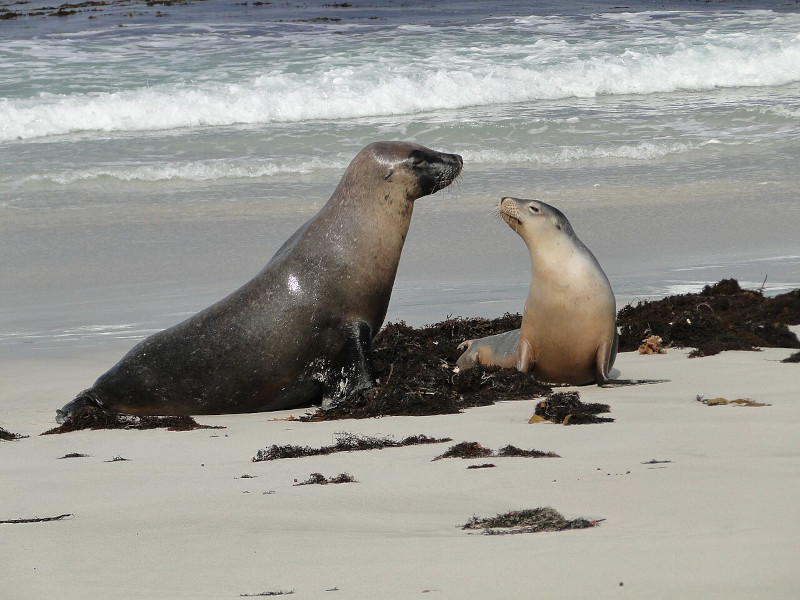
Australian Sea Lion Facts
- This precious product of evolutionary processes most frequently goes by the informative common name of the Australian Sea Lion. It does have a few other general title, though. These include the variations Australian sea-lion and Australian sealion.
- Inside of scientific circles, however, it’s perhaps better known by its technical designation. Thankfully, that’s a moderately simple term for the layperson to pronounce, as such things go. That’s true since it holds the tag Neophoca cinerea.
- The creature received that designation due to the efforts of François Auguste Péron. The respected French naturalist accomplished the first recognition of it as a separate and distinct species. He managed that scientifically noteworthy deed in 1816.
- The marvel of Nature also stands out from its many relatives around the world in several respects. This amazing mammal represents the only pinniped native to its region of the globe. It also presently forms the only surviving member of its Genus.
- Sadly, the beautiful Australian Sea Lion currently has a comparatively low population base. That unfortunate situation holds true across its entire range. Accordingly, the IUCN now classifies it as Endangered on its Red List of Theatened Species.
- Though legally protected, it nevertheless still faces numerous threats to its continued existence as a species. Most of those stem from the actions of man. These dangers include illegal hunting, and the combined effects of habitat loss and climate change.
Related Articles
Australian Sea Lion Physical Description
The gorgeous Australian Sea Lion certainly draws the eye of those fortunate enough to encounter them. Like most of their relatives, though, they do so for more than just their beauty, great though that is. That’s because they also achieve impressive dimensions.
Following yet another pattern common among its kindred, it also displays a certaim amount the of the physiological characteristic of sexual dimorphism. In its specific case, however, this natural trait manifests itself in terms of both pure size and typical coloring alike.
Males of this marvelous mammal attain an average body length equaling approximately 8.2 ft (2.5 m). These same examples further typically achieve a mass measuring roughly 660 lb (300 kg). Exceptional specimens do occur, of course, yet rarely exceed these greatly.
The females, meanwhile, generally reach significantly smaller measurements in both categories. For the, a mean length of body only runs about 5.9 ft (1.8 m). They also have not only shorter body, but a much slimmer form, as well. A mean weight totals 231 lb (105 kg).
But, it’s in the coloring that the Australian Sea Lion displays its other gender-based diferences. Males typically primarily show a background of dark brown. These also display yellow areas on the neck and head. Females are silver-gray on the back, and cream beneath.
Otherwise, the sexes mostly present the same appearance, with a few notable exceptions. They’re noted for their comparatively large head, and more tapered muzzle. The ears are quite smal. Males do have a larger head and broader shoulders than females, though.
- Kingdom: Animalia
- Phylum: Chordata
- Class: Mammalia
- Order: Carnivora
- Family: Otariidae
- Genus: Neophoca
- Species: N. cinerea
Australian Sea Lion Distribution, Habitat, and Ecology
The captivating Australian Sea Lion evolved as endemic to a moderately small section of the surface of the earth. The general location of this zone of habitation certainly isn’t going to surprise anyone, however. As its own name implies, it developed as native to Australia.
Within that greater range, though, its current population is sparsely distributed. This region inhabitation generally extends from the western regions of the coast to similar areas in the southern section. Currently, this range holds only 66 known breeding colonies.
Like many creatures, this wonder of evolution displays decidedly strong preferences regarding its choice of habitat. This does have the effect of limiting its chances of expanding its range, however. It’s non-migratorty in nature, and never strays far from its birthplace.
The majority of its numbers live on offshore islands. The mammal spends the vast majority of its time living and breeding on the beaches near their place of birth. It even stays close to shore when it enters the sea. It’s not been seen at depths greater than 131 ft (40 m).
Being a pinniped, the Australian Sea Lion evolved as a carnivorous species. It also tends to hund and feed opportunistically. The majority of its diet consists of smaller fish varieties. Nonetheless, it also feeds on prey such as cuttlefish, small squid, and crustaceans.
As adults, its own predators include Great White Sharks and Orcas. The young, though, fall victim to these and smaller sharks, too. The infants also sometimes perish due to the actions of adult males of the species, as these occasionally kill the young, even their own.
Species Sharing Its Range
Check out our other articles on 3 Awesome Antarctic Land Species, Eurasian Brown Bear, Komodo Island, Orange Jewelweed, Spinetail mobula, East African Lowland Honey Bee, Jamaican Iguana
